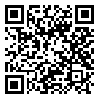Volume 13, Issue 4 (Oct & Nov 2019)
payavard 2019, 13(4): 302-310 |
Back to browse issues page
Download citation:
BibTeX | RIS | EndNote | Medlars | ProCite | Reference Manager | RefWorks
Send citation to:



BibTeX | RIS | EndNote | Medlars | ProCite | Reference Manager | RefWorks
Send citation to:
Ahmadi M, Torabi M, Goodarzi M, Hamidi H, Elmi S, Golmahi F, et al . The Effectiveness Dimensions of Intelligent Secretariat in Tehran University of Medical Sciences. payavard 2019; 13 (4) :302-310
URL: http://payavard.tums.ac.ir/article-1-6867-en.html
URL: http://payavard.tums.ac.ir/article-1-6867-en.html
Maryam Ahmadi1 
 , Mashallah Torabi *
, Mashallah Torabi * 
 2, Maryam Goodarzi3
2, Maryam Goodarzi3 
 , Hamideh Hamidi4
, Hamideh Hamidi4 
 , Samira Elmi5
, Samira Elmi5 
 , Fatemeh Golmahi6
, Fatemeh Golmahi6 
 , Samira Mortezaie7
, Samira Mortezaie7 
 , Parisa Nezari8
, Parisa Nezari8 


 , Mashallah Torabi *
, Mashallah Torabi * 
 2, Maryam Goodarzi3
2, Maryam Goodarzi3 
 , Hamideh Hamidi4
, Hamideh Hamidi4 
 , Samira Elmi5
, Samira Elmi5 
 , Fatemeh Golmahi6
, Fatemeh Golmahi6 
 , Samira Mortezaie7
, Samira Mortezaie7 
 , Parisa Nezari8
, Parisa Nezari8 

1- Master of Science in Information Technology Management, Central Intelligent Secretariat, Desk Service and Office Automation, Tehran University of Medical Sciences, Tehran, Iran
2- Assistant Professor, Research Center for Science and Technology in Medicine, Head of Central Intelligent Secretariat, Desk Service and Office Automation, Tehran University of Medical Sciences, Tehran, Iran ,mtorabi@tums.ac.ir
3- Ph.D. Candidate in Technology Management, Faculty of Management and Economy, Islamic Azad University, Science and Research Branch, Tehran, Iran
4- Master of Science in Industrial Engineering, Central Intelligent Secretariat, Desk Service and Office Automation, Tehran University of Medical Sciences, Tehran, Iran
5- Bachelor of Science in Software Engineering, Central Intelligent Secretariat, Desk Service and Office Automation, Tehran University of Medical Sciences, Tehran, Iran
6- Bachelor of Science in Information Technology Engineering, Central Intelligent Secretariat, Desk Service and Office Automation, Tehran University of Medical Sciences, Tehran, Iran
7- Bachelor of Science in Electronic Engineering, Central Intelligent Secretariat, Desk Service and Office Automation, Tehran University of Medical Sciences, Tehran, Iran
8- Master of Science in Executive Management, Central Intelligent Secretariat, Desk Service and Office Automation, Tehran University of Medical Sciences, Tehran, Iran
2- Assistant Professor, Research Center for Science and Technology in Medicine, Head of Central Intelligent Secretariat, Desk Service and Office Automation, Tehran University of Medical Sciences, Tehran, Iran ,
3- Ph.D. Candidate in Technology Management, Faculty of Management and Economy, Islamic Azad University, Science and Research Branch, Tehran, Iran
4- Master of Science in Industrial Engineering, Central Intelligent Secretariat, Desk Service and Office Automation, Tehran University of Medical Sciences, Tehran, Iran
5- Bachelor of Science in Software Engineering, Central Intelligent Secretariat, Desk Service and Office Automation, Tehran University of Medical Sciences, Tehran, Iran
6- Bachelor of Science in Information Technology Engineering, Central Intelligent Secretariat, Desk Service and Office Automation, Tehran University of Medical Sciences, Tehran, Iran
7- Bachelor of Science in Electronic Engineering, Central Intelligent Secretariat, Desk Service and Office Automation, Tehran University of Medical Sciences, Tehran, Iran
8- Master of Science in Executive Management, Central Intelligent Secretariat, Desk Service and Office Automation, Tehran University of Medical Sciences, Tehran, Iran
Abstract: (2766 Views)
Background and Aim: The purpose of this study was to introduce a new model for indicator of letters in office automation of Tehran University of Medical Sciences.
Materials and Methods: The present study was an applied research and a developmental study in which old automation method has been modified to new model. Regarding to the dispersion of codes assigned to letters, there was no specific order in the codes of both old and new units defined in the system, and firstly, the letter indicators in the office automation system of university in combination with letters and numbers was done without classification, the decision was made to correct it in the office automation system. In new model, numbering the correspondence based on frequency of each university unit's subdivision was described and proposed model was presented.
Results: According to the new numerical model, integrated codes were assigned which were entirely numerical or the combination of numbers. Due to the abundance of units covered by the university, the research centers allocate the largest number to themselves. Therefore, a larger range of indicator codes for these units was considered than for other sections.
Conclusion: This model provides a new model for implementation of office automation indicator code in Tehran University of Medical Sciences and facilitates the search of letters based on the defined number.
Materials and Methods: The present study was an applied research and a developmental study in which old automation method has been modified to new model. Regarding to the dispersion of codes assigned to letters, there was no specific order in the codes of both old and new units defined in the system, and firstly, the letter indicators in the office automation system of university in combination with letters and numbers was done without classification, the decision was made to correct it in the office automation system. In new model, numbering the correspondence based on frequency of each university unit's subdivision was described and proposed model was presented.
Results: According to the new numerical model, integrated codes were assigned which were entirely numerical or the combination of numbers. Due to the abundance of units covered by the university, the research centers allocate the largest number to themselves. Therefore, a larger range of indicator codes for these units was considered than for other sections.
Conclusion: This model provides a new model for implementation of office automation indicator code in Tehran University of Medical Sciences and facilitates the search of letters based on the defined number.
Keywords: Office Automation, Intelligent Secretariat, Indicator, Information Systems Management, Correspondences
Send email to the article author
| Rights and permissions | |
 |
This work is licensed under a Creative Commons Attribution-NonCommercial 4.0 International License. |



